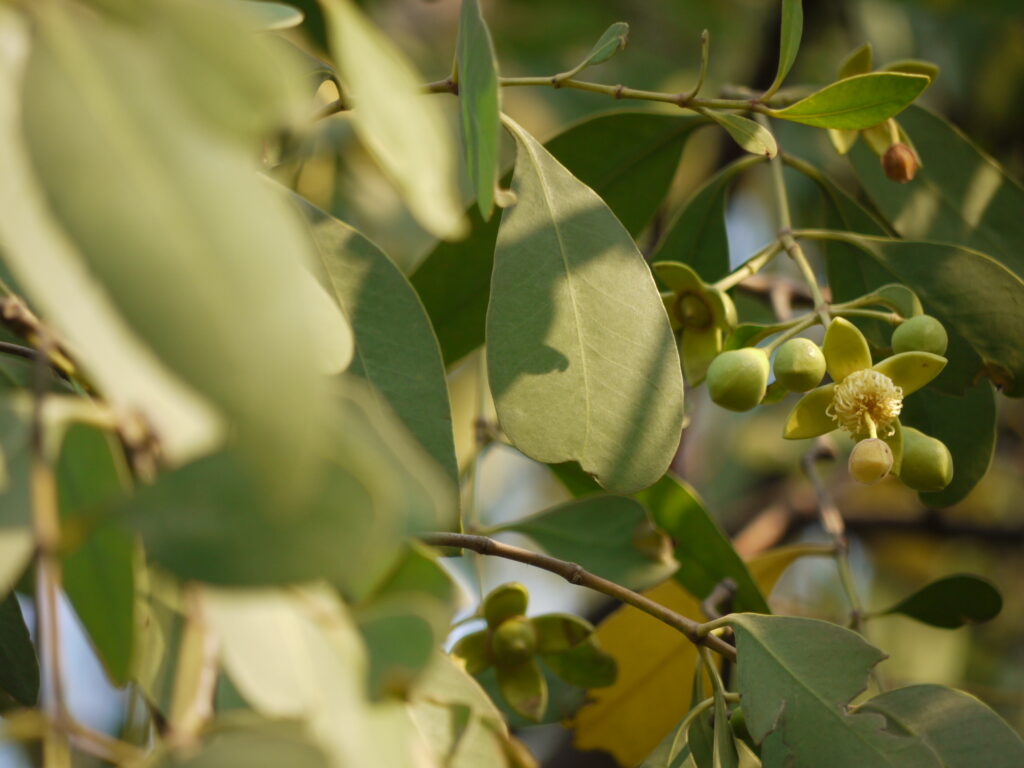Keora (Sonneratia apetala)

Sonneratia apetala, commonly known as Keora or Mangrove Apple, is a mangrove species found in the coastal regions of the Indian subcontinent, Southeast Asia, and southern China. It is a member of the Lythraceae family and is well-adapted to the challenging conditions of mangrove ecosystems, such as high salinity, tidal fluctuations, and waterlogged soils.
Taxonomy of Keora (Sonneratia apetala):
Kingdom: Plantae
Phylum: Tracheophyta
Class: Magnoliopsida
Order: Myrtales
Family: Lythraceae
Genus: Sonneratia
Species: S. apetala
Morphology of Keora (Sonneratia apetala):
- Roots: Keora plants possess an extensive root system with specialized aerial roots known as pneumatophores. These pencil-like, upward-growing roots emerge from the soil and facilitate gas exchange and oxygen absorption in waterlogged conditions.
- Trunk: Sonneratia apetala has a straight, erect trunk with smooth, greyish-brown bark. The trunk can reach a height of up to 20 meters (65 feet) under optimal conditions.
- Leaves: The leaves of Keora are simple, opposite, and elliptic to oblong in shape, measuring around 5-15 cm (2-6 inches) in length and 2.5-7 cm (1-2.75 inches) in width. They have a glossy, dark green upper surface and a paler green underside. The leaf margins are entire, and the midrib is prominent.
- Flowers: Keora plants produce large, showy flowers that are usually white or pale yellow, with a pinkish or reddish tinge at the base. The flowers are nocturnal, opening at night and releasing a strong, sweet fragrance. They have numerous long, slender stamens and a single pistil with a superior ovary.
- Fruits and seeds: The fruit of Keora is a spherical or slightly flattened berry, measuring around 2.5-5 cm (1-2 inches) in diameter. It turns from green to brownish-red or purplish-black when mature. The fruit contains numerous small, ovoid seeds, which are dispersed by water currents and tides.
Explore the natural beauty of Keora (Sonneratia apetala) through a Best Sundarban tour package
The taxonomy and morphology of Keora (Sonneratia apetala) enable it to thrive in the challenging environment of mangrove ecosystems. Its unique features, such as the pneumatophores and salt tolerance, make it an essential component of these habitats and a valuable resource for mangrove restoration efforts.
Keora (Sonneratia apetala), also known as Apple Mangrove or Mangrove Apple, is a species of mangrove tree belonging to the Lythraceae family. It is native to the mangrove forests of the Indian subcontinent, Southeast Asia, and southern China. Keora trees are typically found in coastal areas, particularly along estuaries, tidal creeks, and the seaward edges of mangrove forests, where they can tolerate high levels of salinity.
Keora trees generally grow up to 15-20 meters in height, with some specimens reaching up to 30 meters. The tree has a straight, cylindrical trunk with smooth, gray bark and is often supported by stilt roots or pneumatophores. These aerial roots extend from the trunk or lower branches and help the tree obtain oxygen in the oxygen-poor soil of the mangroves.
The leaves of the Keora tree are simple, opposite, and elliptical, with a shiny, dark green upper surface and a lighter green underside. The tree produces distinctive, large, white flowers with numerous long, slender stamens that give the flowers a spiky appearance. The flowers are nocturnal and emit a strong fragrance to attract pollinators, such as bats and moths. Following pollination, the flowers develop into fleshy, apple-like fruits containing numerous seeds.
Keora trees play a vital role in the mangrove ecosystem, providing habitat and food for various species of birds, fish, and other wildlife. The extensive root system of the tree helps to prevent soil erosion, stabilize shorelines, and maintain water quality by trapping sediments and filtering pollutants.
The wood of the Keora tree is lightweight, soft, and easily workable, making it suitable for various purposes, including construction, boat building, and the production of paper pulp. The fruits are also edible and are sometimes used as a food source by local communities. However, the increasing demand for its wood and habitat loss due to deforestation, aquaculture expansion, and climate change has led to a decline in Keora tree populations. Conservation efforts are necessary to protect these unique trees and the vital ecosystems they support.
search terms : Keora (Sonneratia apetala), Best Sundarban tour package, Sundarban package tour, কেওড়া
Source: We made this page for educational purpose information collected from various sources, if you found any information incorrect, please contact the webmaster.
Sponsor : This page is sponsored by SONAKSHI TRAVELS, dealing with package tour for Sundarban